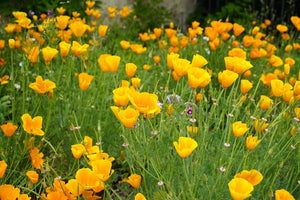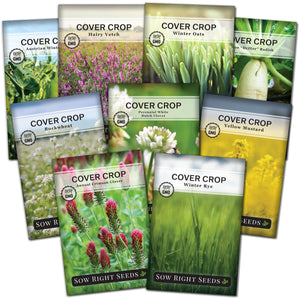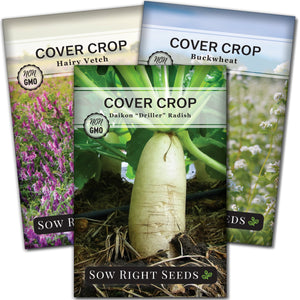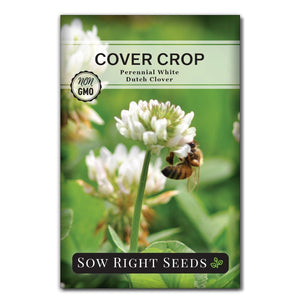Vetch Me If You Can: Planting Hairy Vetch for a Successful Cover Crop
Cover crop growing tipsHairy Vetch is a versatile and valuable annual cover crop that offers numerous benefits for your home garden or farm. This nitrogen-fixing legume is an excellent choice for soil improvement and works well in combination with other cover crops to provide a healthy and productive growing environment. Its versatility makes it an excellent choice for various situations, and with a little creativity, it can be incorporated into almost any rotation.

The Benefits of Hairy Vetch as a Cover Crop
Nitrogen Fixation
Hairy Vetch’s ability to fix nitrogen from the atmosphere into the soil is one of its prime benefits. Like all legumes, it works together with Rhizobium bacteria to convert nitrogen in the air into a form that plants can access by their roots. This enriches the soil and reduces the need for synthetic nitrogen fertilizers, which makes hairy vetch as a cover crop a more sustainable and eco-friendly approach to gardening. It has also been shown in studies that hairy vetch will improve your tomato crop.

Rapid Growth
Hairy Vetch is also known for its rapid growth and dense foliage, which makes it an ideal choice for weed suppression. The thick cover helps to keep unwanted plants in check while simultaneously protecting the soil from erosion. The extensive root system will also help break up clay soil.
Winter Hardiness and Soil Protection
Hairy Vetch's winter hardiness sets it apart from other cover crops. This characteristic allows it to continue growing and providing soil protection during colder months when many other plants are dormant. It effectively preserves soil moisture and prevents nutrient leaching, maintaining healthy soil conditions for your next planting season.
Hairy Vetch is a winter-hardy (to 10°F) and drought-tolerant cover crop that works well on sandy or clay soils. This plant is a legume that fixes large amounts of nitrogen from the air and provides excellent spring weed suppression and erosion control. Works well in tandem with winter rye or winter oats.
Cover crops can help cover the soil of your home garden beds during the off-season. We've included enough seed in one packet to cover an 8' x 4' garden bed. Improving soil health through cover crop planting is an easy and low-cost way of maintaining your garden from year to year.

How to Plant Hairy Vetch as a Cover Crop
To reap the full benefits of Hairy Vetch as a cover crop, sow the seeds in late summer or early fall.
Hairy vetch creates a beneficial amount of biomass if planted at least 40 to 50 days before a killing frost. This gives the plants enough time to establish a good root system before winter.
To plant, broadcast the seeds and work into the soil to a depth of one inch.
If you miss the window for planting, all is not lost! Dormant seeding allows you to get a head start on planting Hairy Vetch for spring. The technique involves planting seeds in the ground before the soil freezes and snow cover arrives, but not so early that warm fall weather encourages sprouting. This approach ensures that the seeds remain dormant and inactive throughout the winter, ready to germinate and grow when the ground thaws.
When spring arrives, simply mow or cut the vetch, then incorporate the residue into the soil as green manure. This process releases the stored nitrogen and other nutrients, making them available for your upcoming crops.

A Winning Combination: Hairy Vetch and Other Cover Crops
Hairy Vetch pairs exceptionally well with other cover crops, creating even more benefits for your garden. Combining Hairy Vetch with cereal grains such as Winter Rye or Winter Oats can provide additional erosion control and weed suppression. The cereal grains’ robust root systems will complement Hairy Vetch's nitrogen-fixing capabilities, resulting in a well-rounded approach to soil improvement.
Plant hairy vetch with Daikon driller radish and buckwheat for a targeted approach to improving heavy clay soil.
Hairy Vetch is an ideal choice for gardeners and farmers looking for an easy-to-grow and versatile cover crop solution. Its nitrogen-fixing properties, rapid growth, winter hardiness, and compatibility with other cover crops make it a valuable addition to your garden.
By planting Hairy Vetch as a cover crop, you'll be setting the stage for a healthy and productive growing environment, increasing the chances of success of future crops.
Written by Teresa Chandler









Doug- Hairy Vetch is winter hardy to 10ºF. You can terminate it by mowing and tilling.
I have about a quarter acre that I’d like to plant with Hairy Vetch in the spring; but I prefer a winter kill like I did this past year with radishes. I live in Idaho so it can get below 10 in the winter.
Can you terminate the veg by mowing and tilling?
Leave a comment